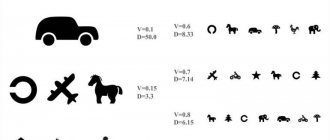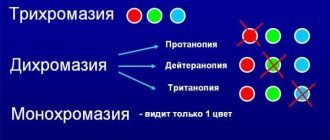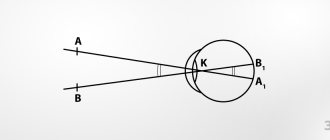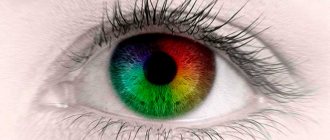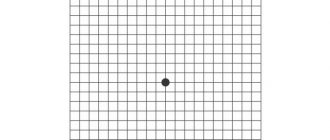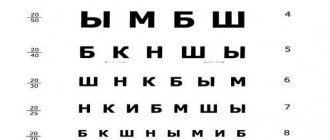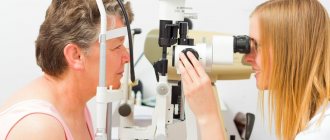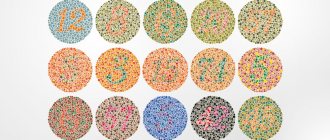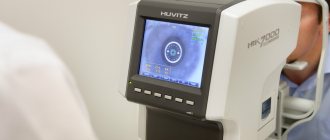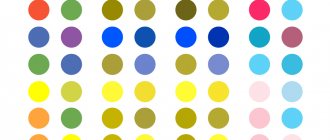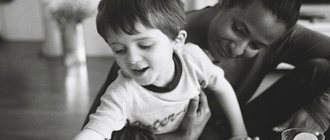Vision is a great gift of nature, which allows a person to contact the world around him on a completely different level, gives him the opportunity to move calmly, live life to the fullest and really see the beauty that surrounds him. Unfortunately, now more and more often our eyes are overloaded, and their health is also affected by a number of negative factors in the environment in which we live. This is why more and more people are complaining that they no longer see so well or perceive the color and shape of objects incorrectly. An eye test can be done at your eye doctor's office. But in some cases, you can roughly assess the condition of your eyes at home. And for this, sometimes it is enough to check your vision online using a table on a computer.
Check your vision online using a table on your computer
What is such a check?
- 4.1 Video: Test - how good your eyesight is
- 6.1 Video: Are you colorblind? Color test
- 8.1 Video: Eye test. Tables
Everyone had their vision tested in the ophthalmologist's office. It is included in the mandatory medical examination program, so everyone is familiar with it. Such a test is, at a minimum, passing a certain test: at some distance from the person sitting in the chair, there is a special table on which letters or pictures are depicted, called optotypes . The table is located directly in front of the eyes. All images on it have a certain size, which changes from top to bottom. The images are black and printed on a white background.
How to test your eyesight
The patient undergoing testing covers one eye with a special spatula and looks at the table with the other, and the doctor, in turn, asks to name what is shown in a certain row and in a certain place. If a person has difficulty assessing the images, then he is given the opportunity to look at them through special lenses. This is how vision clarity is assessed and glasses are selected. There is nothing complicated about this.
How does an ophthalmologist check your eyesight?
There are also certain tests to determine color vision, the presence of astigmatism, etc. They help identify existing or emerging eye problems in each person.
On a note! You can take some tests at home. To do this, you need to print out certain tables or pictures and, following the rules, conduct the test yourself. In some cases, the table does not even need to be printed - now some types of tests can be taken directly online.
My own ophthalmologist
Vision requirements for drivers
So, passing an ophthalmologist is a prerequisite for obtaining an appropriate medical certificate for your license. What exactly is vision tested to obtain a driver's license:
- For the presence of farsightedness or myopia. Visual acuity is the most important indicator of eye health, because without it the driver will not be able to see road signs, pedestrians and other cars around in a timely manner. There are different assumptions here depending on the category of driving license. Thus, visual acuity for categories A and B should be no lower than 0.6 diopters in one eye and 0.2 in the other. For category C, up to 0.8 units are allowed in one eye and 0.4 in the other. If one eye of a person does not see, then the second must have a visual acuity of at least 0.8 units. With equal readings in both eyes, the required visual acuity is not lower than 0.7 units.
- For problems with color vision. This indicator is also crucial when issuing a driver's license. The driver must see all colors perfectly, because he will have to distinguish between traffic lights, markings, road signs and other objects around. If a person is diagnosed with color blindness, then issuing a license for him is prohibited.
- For problems with viewing width. Everything is simple here. The greater the angle of space a person sees, the greater his chances for a quick reaction if quick maneuvering is necessary. This is necessary for the driver himself. Fortunately, many of the causes of decreased viewing angles are now being corrected therapeutically, and therefore this problem is fixable.
- For the presence of ophthalmological diseases. It also matters what category of driver’s license a person needs. Thus, glaucoma is a contraindication to obtaining a category A license, but this disease is not included in the list of contraindications for driving a car (category B).
Based on the results of the examination, the ophthalmologist decides whether the person can be allowed to drive a vehicle.
Rules for taking tests at home
In order for “home” testing to show reliable results, certain rules for completing tasks must be followed. The main ones are the following.
Rules for testing visual acuity
- The lighting in the room should be good, but natural, and not overly bright. Too bright a light can cause a strong constriction of the pupil, which will cause an error in the results - the eye muscles will be too tense. But too dim light is also bad. It enlarges the pupil and can also strain the eyes.
- The distance from the table or image to the patient’s eyes must be certain - about 5 m when using a test with optotypes.
- If tables with optotypes are used, then an assistant is needed. It will require someone to point to the optotypes and a person to read them.
- It is important to take the test only when you are feeling well. When a person is sick, his vision can deteriorate reversibly. Thus, the results will be distorted.
- Squinting your eyes and tilting your head is prohibited.
- Before the test, you should not engage in activities that require close attention and serious eye strain. So, it is not recommended to read, draw, sew, etc.
- You must take the tests while sober. It is important for smokers not to smoke for at least a couple of hours before testing.
When checking your vision, you need to follow certain rules
You can now take an eye test online. In this case, no assistants are needed and compliance with certain specific rules is also not necessary. Just turn on your computer, find the site you need and start testing. But first, let’s take a closer look at the possible testing options and the formats of the tables used to check the quality of vision.
Special tables are used for checking
Optometrist and ophthalmologist, what is the difference?
There is an opinion that an ophthalmologist, when compared with an ophthalmologist, has higher qualifications and a wide range of permitted actions on the eyes.
And the ophthalmologist only conducts outpatient appointments, checks the quality of vision and writes prescriptions for glasses. An ophthalmologist, according to this opinion, is a specialist of the highest class who treats complex diseases and operates on the eyes. And there is often confusion among patients about the differences between these specialists.
In practice, these are two synonyms! The concept of “ophthalmologist” has become more widespread only among patients. An ophthalmologist is a practicing doctor with a special higher education.
Both an ophthalmologist and an ophthalmologist are well aware of the anatomical and physiological features of the visual apparatus. They also know modern diagnostic and therapeutic methods. They have an identical range of responsibilities, which include timely detection of pathology, implementation of complex therapy and organization of preventive actions.
Checking visual acuity
To find out how sharp your vision is, you will have to undergo testing using a series of tables. They are printed, and the test at home is much the same as in the ophthalmologist's office.
Sivtsev table
Sivtsev’s table is an image with letters of the alphabet of different sizes printed on it. To create it, only 7 letters of the alphabet were used (M, K, N, Sh, Y, I, B), but they have different combinations and different sizes. Moreover, in one line all characters will have the same width and height.
Sivtsev table
Table. Parameters of the Sivtsev table.
| Parameter | Indicators |
| Vision test interval | 0.1-5.0 dioptres |
| Distance to table | 5 m |
| Step between the first 10 rows (0.1-1.0 diopters) | 0.1 diopter |
| Step between 11 and 12 rows (1.5-2.0 diopters) | 0.5 dioptres |
| Step between the last additional rows (3.0-5.0 diopters) | 1.0 diopter |
The table is also equipped with additional columns, where D is the distance (m), showing from what distance the image is clearly seen by a person with excellent vision. The second column, labeled V, demonstrates visual acuity if a particular row is read at a distance of 5 m. A person with good vision is able to read row number 10 at a distance of 5 m.
Visual acuity test
Advice! When passing the test using this table, you should illuminate it with an incandescent lamp (1 pc.) or fluorescent lamps (2 pcs.) to an illumination level of 700 lux. In this case, the light should fall only on the table, and not on the person’s face.
It is recommended to take the test using Sivtsev’s table by printing it on paper. But you can also go through it from a computer monitor. The rules are the same. It is only important to consider the scale of the image.
Eye test charts
Other table options
The Orlova table is an analogue of the table described above, but it is intended for testing vision in young patients. Instead of letters, it depicts drawings of animals, which also change size from large to small from top to bottom. Similar to the table above, this one has lines D and V. A child with 100% vision should see line No. 10 perfectly from a distance of 5 m .
Orlova table
There are other symbols in Golovin's table. Optotypes of a certain shape are used. These are rings that have breaks. They, similar to the previous options, can also have different sizes in each specific row. This table works exactly the same as the two previous options.
Golovin table for testing visual acuity
There is also Rosenbaum's table. It is a tabletop plate, which, unlike the options described above, is placed at a distance of only 36 cm. Optotypes are the letters E, turned in different directions, zeros and crosses, numbers.
Rosenbaum tabletop
On a note! According to this table, the quality of vision is determined in other units of measurement - Jaeger.
Eyesight check
We have all been to an ophthalmologist's office more than once, where we were always asked to read the letters on a sign hanging on the opposite wall. Some people are also given a book to look at with randomly arranged colored dots at first glance, from which, in our eyes, they should form numbers and geometric shapes. These are the most common ways to test vision. What do they tell the doctor and are there any others?
Types of vision tests
The well-known tablet with lines of letters of different sizes is called the Golovin-Sivtsev table, in honor of the ophthalmologists who developed it. The table includes 12 rows of letters of different sizes, and the patient must read these letters alternately from a distance of 6 meters, first with one eye and then with the other.
The lowest row, in which he manages to read most of the letters, characterizes distance visual acuity. The third row from the bottom of the table corresponds to 100% visual acuity, the one above it corresponds to 90%, and so on.
The bottom two lines correspond to increased visual acuity, which often indicates farsightedness.
To check visual acuity in children and adults who cannot read, similar tables are used, in which, instead of letters, rings with a small cut looking in different directions (Golovin’s table) or various pictures (Orlova’s table) are depicted. The patient must determine, accordingly, in which direction the cut of the ring is facing or which picture is depicted.
Using the same tables, glasses (contact lenses) are selected. The patient is put on a special trial frame, into which diagnostic lenses of different optical powers are inserted one by one. Thus, the doctor selects lenses with which the patient’s vision becomes as close as possible to unity. This procedure is called a refractive examination.
The near vision test uses a small card with several paragraphs of text, each printed in letters of different sizes. The patient reads this text from a distance of 33-35 cm.
Pictures with colored dots and circles allow you to determine the correctness of color perception. The colored circles form numbers and shapes that can be correctly named by a person with normal color perception. If color perception is impaired, a person will see other numbers and figures, or will not see them at all. Based on which images the patient recognized correctly and which he made a mistake, the doctor determines which color perception is impaired and to what extent.
How often should you have your eyes checked?
It is recommended to have your eyes checked annually:
- schoolchildren;
- students;
- employees whose work involves significant eye strain;
- elderly people (over 65 years old).
If your vision is not subject to heavy loads, then from the ages of 18 to 64 you can check it once every 2 years.
These recommendations apply to people who do not have serious vision problems. If any are present, the doctor, as a rule, prescribes more frequent monitoring.
How to Prepare for an Eye Test
There is no special preparation required for the vision test, but there are still some recommendations that need to be followed.
- You should come to the doctor rested and sober. Fatigue, drowsiness, and exposure to alcohol (including alcohol consumed yesterday or the day before) can seriously distort the result.
- Taking certain medications can also negatively affect the test result, distorting it in one direction or another. Therefore, 2-3 days before your visit to the ophthalmologist, try not to take any medications; If this is not possible, be sure to tell your doctor about the medications you are taking.
- If you use glasses or contact lenses, take them with you (all if you have more than one). The doctor should check your vision both without and with them. Also, if you have any, take your previously written prescriptions for glasses (lenses).
- Be prepared to answer your doctor's questions about what specific vision problems you are experiencing.
Should I test my eyesight at home?
Currently, any vision test tables can be purchased in stores, downloaded from the Internet and printed; Many websites also offer online vision testing services.
Of course, you can take advantage of all these opportunities to test your vision at home and perform periodic self-monitoring. But remember that the result of all these checks will be very inaccurate and approximate.
After all, at home it is almost impossible to meet all the conditions for a correct vision test: the correct location of the tables, their illumination, the contrast of the characters if you print them yourself, etc.
Online tests and various programs give even less accurate results.
Even if we omit the points related to the medical competence of the creators of these sites and programs and assume that you have found a test developed and implemented by truly professionals, you must remember that, in addition to the factors listed in the previous paragraph, the results of tests performed on a computer have a huge impact also the parameters of your monitor - its size, quality, settings. Therefore, the results of even the same test, but done on different computers, can differ very, very much.
Therefore, of course, it is possible to carry out such checks at home, but in no case should they replace a visit to the doctor. Only an ophthalmologist will be able to check your vision with the required accuracy, conduct other examinations if necessary (for example, examining the fundus of the eye or checking intraocular pressure), choose the right glasses (contact lenses), and prescribe treatment.
Source: https://comp-doctor.ru/eye/proverka-zreniya.php
Detecting farsightedness and nearsightedness
There is a so-called duochrome test that helps determine whether a person is farsighted or nearsighted. It is a set of letters printed on a red and green background.
Duochrome test
The test is carried out with correction devices on (for example, glasses), for each eye in turn. So, normally the patient sees the letters on both sides of the picture the same way - they do not differ in clarity or brightness. But if the letters on a red background are clearer than on a green one, then the person most likely has problems with seeing objects in the distance. If on the contrary, then the patient is farsighted.
Myopia and farsightedness
Video: Test - how good your eyesight is
Testing for astigmatism
You can also take a test for astigmatism at home. The special images below are used. You need to look at them from a distance of about 3-5 steps and evaluate the clarity and color of the lines. If some of them look brighter or dimmer, then the likelihood of astigmatism is high.
Astigmatism test
Same with the squares in the figure below. If you close one eyeball, then with 100% vision the squares will be the same color. If some of it turns gray, then perhaps the person has a pathology.
Another test for astigmatism
The Siemens Star will also help suggest whether a person has astigmatism. If it is present, then the rays, not yet reaching the central part of the picture, will layer and blur, and in some places merge with each other. But in the center they will again be clearly visible. A peculiar negative effect appears when the patient notices a white background instead of black stripes, and dark stripes instead of a white background. Also, in the presence of pathology, the rays will form not a circle, but an ellipse.
Astigmatism. What it is
How to remember a table
There are several methods by which you can go through the table if you have poor vision:
- learn the letters by heart in sequence from top to bottom, since it is in this order that the ophthalmologist points to them;
- memorize the letters, using their ghosting into poetic form (this complicates the process, since the ophthalmologist points to the letters very quickly, it will be difficult for the patient to remember the entire poem at once).
The diagnostic table shows a small number of letters of the Russian alphabet, so it will be very easy to remember them.
In some cases, only the diagnostic table method is used, without using other tests. Therefore, you can wear corrective lenses, with which you can see both the first and last line.
We check color perception and color perception
You can also test your color perception at home using a special image painted in a large number of colors. This type of test allows you to determine how many types of cones are on the retina. Not all people are able to see all colors of the same spectrum equally.
Color vision test
In this case, to check, it is enough to count the number of visible colors.
Table. Evaluation of results.
| Number of flowers, pcs. | results |
| Less than 20 | Dichromat Man. Its eye has only two types of cones. About 25% of all people fall into this category. |
| 20-32 | The patient is a trichromat. A person has three types of photosensitive elements. These people can distinguish quite a lot of shades in the red, green, and also blue regions of the spectrum. Approximately 50% fall into this category. |
| 32-39 | This is a tetrachromat. Such people have four types of photosensitive elements and do not like the color yellow. About 25% of all people fall into this category. |
| Over 39 | It is recommended to count the number of colors again. In fact, it is extremely difficult to see more than 35, given that the image is located on a computer monitor. |
Color perception can be checked using Rabkin tables. Simply put, this is a test for color blindness. The tables are multi-colored images, some of which cannot be distinguished by people with pathologies in the field of color perception.
Some of Rabkin's tables (color blindness test)
Video: Are you colorblind? Color test
Check your vision for color vision. How is an eye test for color blindness done?
Checking your eyesight using pictures, color perception photos Previously, it was possible to check your eyesight for color perception only during an examination by an ophthalmologist , but today, this can be done right at home or in your office, without getting up from your laptop or computer.
The test consists of viewing special, multi-colored Rabkin tables, which reveal a person’s color vision impairment. Color blindness (or in other words, color blindness) is a violation of color vision.
With such a pathology, the human eye cannot distinguish either one or several colors and their shades.
Often, color blindness is hereditary in nature, which is associated with disorders that have occurred in the X chromosome. The pathology is transmitted from the mother (through the female line), she is the carrier of the disease, but men often suffer from it. Sometimes this disease can be acquired.
Color blindness is a consequence of diseases associated with the retina or optic nerve that are not inherited. It is difficult for the patient to distinguish between yellow and blue colors. The most common cause of color blindness is cataracts. The retina contains special light-sensitive nerve cells called cones.
They are the ones who give a person adequate color perception. There are three types of cones, each of which has a specific color: red, blue and green.
A certain test allows you to check your vision for color blindness , during which the patient is shown pictures consisting of multi-colored circles. They form certain figures or numbers. If the subject has problems with the perception of colors, then he will not be able to distinguish the figures, or he will see completely different signs. When conducting this test, the following conditions must be met:
- the study should be carried out when the patient is in good health;
- the room should be well lit;
- the distance should be convenient for the person;
- the time to recognize one picture does not exceed ten seconds.
How to test your vision using pictures? Color perception: dark and bright circles in pictures
Check your eyesight using pictures, color perception photos. If a person has normal color perception, then he uses all three types of cones, that is, visual receptors. This type of people is called trichromats. Colorblind people in most cases cannot discern one or a couple of primary colors. When a person cannot distinguish any colors, this is called color blindness.
If you do not perceive red color, the pathology is called protanopia, blue color is tritanopia (this disease is very rare), and green color is deuteranopia. The only and main sign of color blindness is impaired color perception. Complicated forms, such as the absolute absence of color vision, are rare. Usually the patient cannot distinguish only shades.
Despite the fact that the symptoms of color blindness appear since childhood, a person may simply not notice deviations in color perception. Sometimes it is necessary to conduct a full examination by an ophthalmologist in order to identify pathology. To test for color blindness, special polychromatic tables are used.
Each of them is represented by colored circles that are the same in brightness, but slightly different in color. If a person does not distinguish the colors present in the picture, then it will seem completely homogeneous to him.
And with normal vision, it will be possible to distinguish certain numbers or figures formed by circles of the same color.
How can you get your eyesight checked? Sivtsev table for research
The most commonly used table that helps check vision is the Sivtsev table. It received its name in honor of an experienced ophthalmologist - Sivtsev.
In this table there are lines on which capital letters are placed (a total of twelve lines), while the size of the letters gradually decreases from one line to another, if you move from top to bottom. On the left side of each line, a meter distance is indicated - D, from which the test subject must distinguish letters, provided that he has good vision.
By the way, touching on the topic at what distance the eyesight is checked by an ophthalmologist , I would like to note that the top row should be visible to a person from five meters, and the bottom row - from about 2.5 meters.
Source: https://womanjournal.org/zdorovie/zabolevaniya/480-proverit-zrenie-na-cvetovospriyatie-kak-prohodit-proverka-zreniya-na-daltonizm.html
Definition of macular degeneration
You can determine the presence of macular degeneration, that is, check the central field of vision, using the following test - the Amsler test. It takes only 10-15 seconds. It is recommended to undergo it regularly, especially for older people.
Amsler test
It is required to put on glasses or lenses, if a person uses them, then look at the image below from a distance of 25-30 cm with each eye. In this case, you should focus on the central point in the middle of the picture. If the image is clear, then there are no problems, but if the reticle is distorted, then it is important to contact an ophthalmologist as soon as possible. Distortions indicate the presence of a number of pathological processes.
Test results - normal and pathological mesh
Online vision test
You can also take a general vision test online. To do this, you need to find a suitable site and run the test. You need to perform it at a distance of about 50-70 cm from the screen, and the monitor should be at eye level. Let's look at one example of such an online test.
Step 1. In this picture, you should evaluate the direction of the open side of the letter E.
Estimate the direction of the open side of the letter E
Step 2: Next, you need to press the arrow key corresponding to the selection.
Click on the corresponding arrow
Step 3. Gradually the size of the letter will change. You should continue to take the test, also choosing a specific arrow opposite the answer.
Continue taking the test
Step 4. After testing is completed, the results will appear. It is important to remember that the test is for informational purposes only. If the results are unsatisfactory, you should contact a specialist.
results
We study the tables of letters for checking vision at the ophthalmologist
There are many diseases of the eye apparatus, due to which visual acuity deteriorates. Prevention is of great importance. Therefore, doctors advise regular check-ups in order to promptly detect the onset of pathological changes. One of the effective methods of vision control is the use of tables at home, which ophthalmologists use in their practice.
Eye test chart
Types of diagnostic schemes
Every person, including children, had to be examined by an ophthalmologist. A vision test is a mandatory procedure when undergoing an annual medical examination. This is especially true for people whose activities require the visual system to function normally.
A complete diagnosis of the visual system, which is carried out by qualified specialists, involves studying the medical record and conducting tests to determine how well the patient’s eyes are functioning.
Check with an ophthalmologist
Depending on who is being diagnosed, to check visual acuity, the ophthalmologist uses a table that contains similar signs (optotypes): letters, rings or pictures. The last option is intended for children who do not yet know how to read and write and find it difficult to determine the right and left sides.
Vision testing is carried out using several types of tables:
- Sivtsev (contains 12 lines of letters of different sizes);
- Snellen (there are 11 lines with one of the largest characters at the top);
- The head (consists of a set of rings that have breaks on one side and also decrease in size with each line);
- Orlova (represents a table consisting of certain pictures).
A polychromatic vision table for drivers has also been developed, thanks to which the ophthalmologist can detect color vision disorders.
Sivtsev table
How to do an eye test without going to an ophthalmologist? After all, there is not always free time to sign up for a full diagnostic test at the clinic. Thanks to the Internet, you will be able to take care of prevention yourself, which will help you detect vision problems in time. Any table can be downloaded and then printed on a white matte A4 sheet. The printed diagram must be mounted on the wall so that line 10 is at eye level.
The table must be well lit. When checking, one eye is covered. The depicted optotypes should be viewed from a certain distance. According to the rules, 2-3 seconds are allotted for recognizing one letter. There are some differences in how each table is used.
Letter table
If you were able to download and print Sivtsev’s table, which is shown in the photo, then the severity is examined as follows:
- To look at the diagram, you should be at a distance of 5 meters from it.
- First, cover the left eye with your palm or a piece of cardboard.
- You must start with the first letter located in the upper left corner. Optotypes are read in order.
- Next, the right eye is closed and the procedure is repeated.
If you can clearly distinguish the letters present in the first 10 lines, your vision is considered normal. However, this test is not able to determine the presence of farsightedness.
Snellen chart
The Snellen chart is used from a distance of 6 meters. It contains Latin letters and is used abroad. The absence of vision problems is indicated by a person’s ability to read the optotypes in the last row.
You can print Golovin’s table on A4 sheet and use it together with Sivtsev’s diagram. Vision diagnostics is carried out in the same way in both cases. The only difference is that in the first version, instead of letters, there are combinations of rings.
Golovin table
An important condition when conducting research is inner peace.
Detection of color vision disorders
Before receiving the right to drive a vehicle, drivers are required to undergo an ophthalmologist. People who are going to drive must have excellent vision.
The table of letters for testing vision at an ophthalmologist is the same as for the others. In addition, drivers must recognize colors, otherwise they will have difficulty navigating traffic lights. Therefore, in addition to the table with letters, polychromatic tests are used. Of these, Rabkin's schemes are very popular.
Rabkin scheme
What is the peculiarity of this technique? The table with which the ophthalmologist determines existing color vision disorders is a drawing containing dots and circles of different shades and sizes. When drivers start looking at one diagram after another, the optometrist understands whether there are deviations or not. Pathology is diagnosed when the subject does not distinguish colors, and accordingly, he cannot see the hidden picture.
To test drivers, ophthalmologists use a special book, which is presented with a whole set of tests.
Diagnostics is carried out subject to a number of conditions:
- You need to look at the images in daylight, and you should sit with your back to the window.
- The pictures are placed in a vertical position at a meter distance.
- Recognition of one pattern should last a maximum of 7 seconds.
Everyone has the opportunity to carry out a vision test on their own, using the services of specialized sites.
Examination of preschool children
You can make sure that a child has no visual impairments not only at an appointment with an ophthalmologist, but also at home. It is easy to print out a table for testing children's vision at an ophthalmologist for independent use. It can be seen in the photo. The scheme, containing various pictures, is intended for children who do not yet attend school.
Table for children
How to determine that a child does not have any disorders? If he managed to recognize the images of the 10th row with each eye, then everything is in order with his vision.
Conditions for the test:
- Before the diagnosis, the baby is shown pictures, the names of which he must independently voice.
- It is necessary to explain to the child that the table should be viewed relaxed and without squinting.
If any line is difficult to recognize, the baby can come up half a meter. Diagnostics are carried out until the child names the correctly depicted figures in the 10th row.
You can study visual acuity yourself by taking the test online or downloading the appropriate diagrams. Thanks to such actions, it will be possible to notice unwanted violations in time.
Source: https://ya-viju.ru/tablicy-bukv
